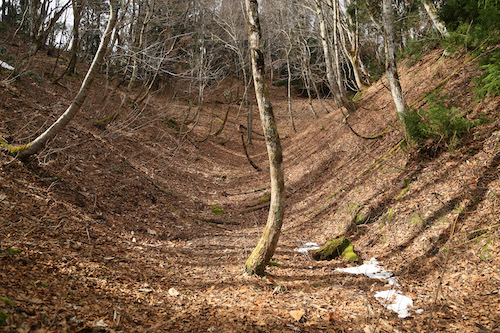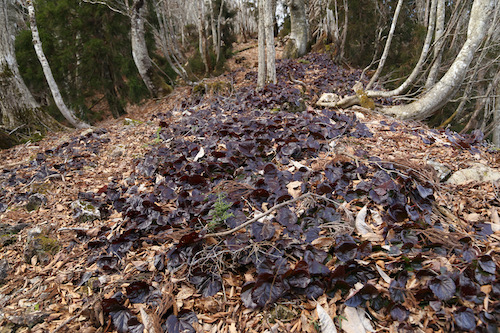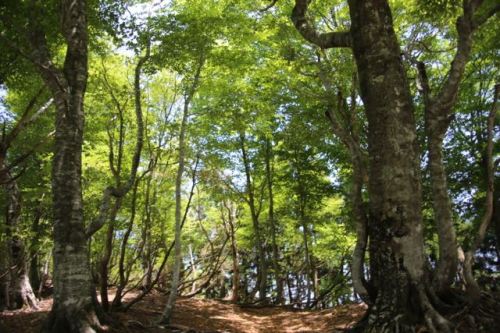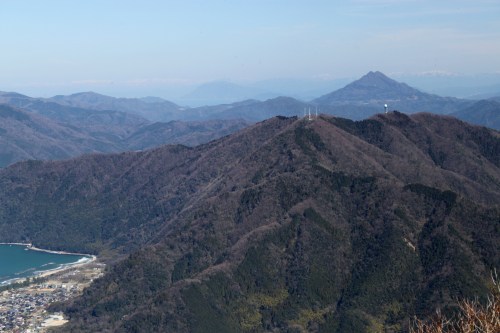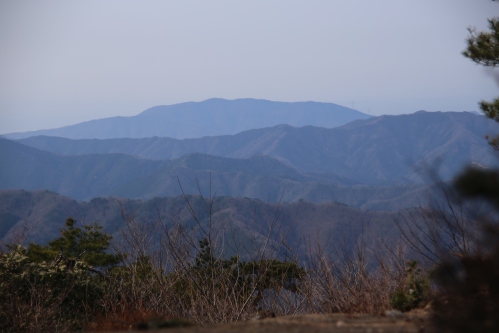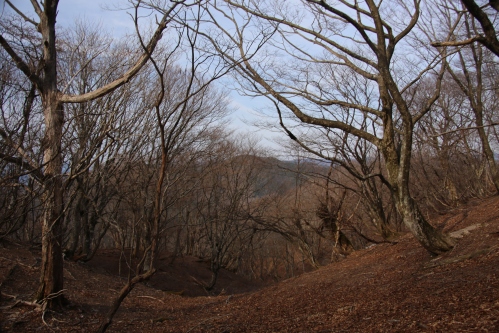For the third week running, on the first of April no less, Ted and I find ourselves parked under the plum tree at the Family Mart in Ōhara, stocking up on provisions to not only sustain us on today’s hike, but also for the long drive up to the Oisugi settlement in the upper reaches of Kutsuki village. The previous week, we had driven the car along the forest road to the headwaters of the Adogawa, but this time we park the car across from Omiya shrine at a junction of two crossroads. Our plan is simple: take the left fork and retrace our steps to Nabekubo-tōge and continue our northern hike along the Takashima to Onyū-tōge and follow the old Saba-kaidō back to our car.

We make good time on the drive and arrive at the shrine shortly after 8am, greeted by a plum tree in full bloom. The bare ridge soars above the collection of depilated dwellings in the hamlet, some of which are in desperate need of re-thatching. Upkeep on these traditional thatched farmhouses is extremely costly, so it’s no surprise that most homeowners of limited means simply cover the thatch with a more durable corrugated metal. An informative signboard sits in front of a recently constructed restroom facility, providing yet another relief of the bowels before commencing on the long slog back to Takashima’s hidden ridge.

The hamlet remains quiet and still in the light of the early morning, with nary a soul in sight — though to the trained eye you can just about make out the eyes peering from behind drawn curtains gazing suspiciously at the two masked foreigners marching through their front yard. We reach the trailhead in about 15 minutes, drop the facemasks, and follow the brook upstream toward where we had last left the Takashima. Despite it being a week between our last visit, the trail is hard to pick up in places, but thanks to our digital aid we soon find the correct tributary and reach Nabekubo-tōge (25) about an hour after leaving the car. We turn right, initially accompanied by a dense cedar plantation on our right before the completely natural forest takes over at the top of a steep rise.

Through a gap in the trees, the adjacent folds of mountain ridges appear to be sprinkled with dandruff flakes, but upon closer inspection Ted and I let out a yelp of joy to discover that the hills are ablaze in the brilliant white petals of the mighty kobushi or Magnolia kobus. These stalwart deciduous trees feature a six-fingered glove of bright white flowers covering their upper branches. They are a sight to behold and really do give the cherry blossoms a run for their money for those lucky enough to come across them.

These signs of spring bring a welcome vitality to our walk, and at the crest of our first unmarked peak a green waymark shows a horizontal distance of just 4.8km to Onyū-tōge, our planned departure point. “We could be back at the car by noon at this rate”, exclaims Ted. The Takashima thinks otherwise.

Never judge a route by the horizontal distance to be covered — a vertical elevation profile is a much better way to access a walk. Without such vital information our hike turns into a roller coaster of a ridge walk, as it rises up and over a series of smaller peaks before dropping to a long saddle and turning into what Amber Heard’s lawyer can only describe as a ‘mega’ slog. I turn around and give Ted that all-too-familiar look indicating the start of a big climb. It won’t be the first time that expression is painted on my face on this fateful day.

Our conversation peters out to a series of grunts and profanities, mostly from my motormouth as I dig deep within my depleted energy reserves. It is best just to lower your head and work through the discomfort of the straining calf muscles as the feet struggle to continue their upward fight against gravity. The one upside to our muscular torment is that the scenery is second-to-none. Never in my wildest dream would I think that such an untouched and sprawling beech forest snuggles the Shiga-Fukui prefectural border along the central divide. Such spectacular beauty gives us the impetus to continue our forward progress. Giving up would be out of the question.

Even though our pace resembles that of an injured turtle, we somehow reach the summit of peak 803 in less time than indicated on the map. This gain in time, however, is quickly lost as we settle in for a well-deserved mid-morning snack and leisurely break. Once again, Lara comes to the rescue as Ted and I continue to expose each other to new trail nibbles. These all-natural fruit bars satiate our appetite and the caffeinated sports Yōkan helps us ward off the drowsiness caused by the 3am alarm clock. Restored vigor leads to a timely photo opp in the gap between two beech trees joined at the hips.

Our route diverges northwest briefly and drops to a tiny pond marked on the map as Okusuge, though there is nothing in the way of a signpost to indicate an official name for the nearly-dried marsh. Perhaps this area is a bit wetter in the summer season. We skirt around this depression and follow the tape marks as we change directions to the east and head upwards toward yet another unnamed peak. About two-thirds of the way up this slope we pass by an enormous horse-chestnut tree that appears to be home to a bear’s feeding platform. We don’t loiter around long to enough to check for inhabitants.

At the crest of the rise we once again teeter on the sea-saw ridge, taking in the views between gaps in the trees while the talk turns to vaccinations. Japan is about 6 months behind the rest of the world rolling out the inevitable inoculation as we place bets on which will come first, our completion of the Takashima, or our turn at the needle.

Those dark olive leaves of the diapensia plants that have been accompanying us on our journey finally show us their reproductive parts, as a series of majestic pink petals of the iwakagami flower finally begin to open. We can sense that summer is just around the corner as the rising heat of the late morning coaxes us to roll up our sleeves and make quick work of the ridge. Soon enough we spot a sign of encouragement: 700 meters to Onyū-tōge. I quicken my pace in anticipation of our arrival, only to be thwarted by the abrupt change in grade. It feels as if Ted and I are climbing up the transition of the quarter pipe of the Megaramp. Our only solace is that the vistas have really opened up behind us, revealing the Hira mountains in all of their beauty.

We enter a dry area of crumbly dirt scree sandwiched between groves of giant beech and cedar. Sweat flows freely from our temples as I once again gaze back at Ted in disbelief. If not for the proximity of the mountain pass I would surely like nothing more than to slouch down for a long break. At long last, we reach the top of yet another unnamed peak and find a sign informing us that our break point is just 100 meters to our right. We coast down to the paved road awaiting us at Onyū-tōge (24), the first asphalt crossing of the Takashima (or final crossing if you’re doing this hike in reverse). This would be an ideal place for your support team to greet you with cold drinks and a well-prepared meal but on this particular Wednesday, there is nary a soul in sight.

Instead of breaking here and heading off the trail, we discover that another pass is just a further 700 meters along the ridge, so after walking on asphalt for a few minutes we duck back into tree cover and reach Negorizaka-tōge at 11:35am, well ahead of schedule. This is the junction of the Saba-kaidō or old mackerel road, a route that fishmongers once used to deliver fresh fish to landlocked Kyoto city. We sit next to an old jizō statue and pore over the maps while chowing down on rice balls and other carb-laced delicacies. I remember this pass during my first climb of Hyakuri back in 2014 but never thought I would be sitting here 7 years later contemplating a second round with the mighty beast, but here we are.

Since it is still before noon, I propose to Ted that we should not only ascend Hyakuri this afternoon, but we should also continue along the ridge another 2-1/2km to Kijiyama-tōge, which will put us in good shape for our next stage of the trail. The only challenge with this is that we will have to retrace our steps back to Negorizaka-tōge so we can descend back to the car. Future Takashima trekkers should take note that section hiking this trail with only one automobile certainly is not the most efficient way to do the hike.

I guide Ted along this next section of path, pointing out landmarks that I remember from 7 years ago and giving plenty of warning to the steepness of the climb. With such pleasant weather we can see Hyakuri towering directly above us, which is both a blessing and a curse — for we can see what needs to be done before we can breach the fortress walls. Fixed ropes are a welcome addition as we push on through the lunch hour. We simply lower our heads as the switchbacks continue to steepen and dig deep within our inner strength as we inch toward the panoramic views of majestic summit. We surprise ourselves by popping out on top of Mt Hyakuri-ga-take (22) shortly before 12:30pm.

An elderly gentleman is settled in for a lunch break as we usher a quick greeting. He has climbed from the Fukui side of the mountain and is just as surprised to see us as we are to see him. Despite being three days into our trek, he is the first hiker we have come across, a testament to the remoteness of the Takashima trail and the difficulty of access. Instead of breaking here, Ted and I continue due north and immediately start losing altitude: the beech gives way to cedar and cypress before flattening out on an elongated ridge. We push past peak 711, vowing to have our own convenience store-inspired break on the return. The map indicates a 70 minute journey to Kijiyama-tōge (21) but we reach it in just 45 minutes and pause just long enough to snap a photo before turning around for our re-ascent of Hyakuri.

Peak 711 can not come soon enough as Ted and I settle among the rock formations on our pre-determined break point. I bust out the chocolate while Ted polishes off the afternoon tea bottle and we once again stare at the maps, wondering if we will be able to complete our hike before dark. The one advantage we have is that I know the route we need to take as it is the same descent trail I took back in 2014. After our invigorating snack, we force ourselves to our feet for the excruciating return to the summit. Three hundred vertical meters later, with burning calfs and tingly thighs, Ted and I give each other a high-five back on the top of Hyakuri and really take time to cherish the views. Time check: 2:04pm. We do in 90 minutes what most hikers would usually accomplish in well over 2 hours.

The drop off of Hyakuri is agonizing, but the fixed ropes aid in cushioning our descent. The most demoralizing part of the route is that, once you pass a junction for the Hyakuri Shindō route, you have to climb up Mt Hakuishi before dropping back to Negorizaka-tōge, but three-quarters of the way up, we discover a faint path to our right that avoids the summit and meets up with the track shortly before the pass. We would like to thank the kind animal that forged that path for us, even if it was made by the shapeshifting kitsune.

With no time to waste we immediately turn left at Negorizaka-tōge and bade farewell to the Takashima in favor of the Saba-kaidō. The route parallels a paved road and meets it briefly once, but for the most part we stay in the forest and navigate through a cluster of truly stunning Magnolia kobus trees in full bloom. The late afternoon light illuminates the petals like a spotlight on a stage actor and with no more ascents between us and the car the smiles once again return to our exhausted faces. At the bottom of the valley Ted admits that in his walk of the Saba-kaidō he somehow completely missed this section. Instead, he seems to have spent most of his time bushwhacking up a parallel valley if his memory serves him correctly. The last 20 minutes back to the car is a breeze, and with the fading light of the day we are already strategizing about stage 4 of our hike. For one, we will no longer be required to access the trail from this valley. We can now turn our attention to Aso village at the base of Kijiyama. Can we knock off the next section before Golden Week?




